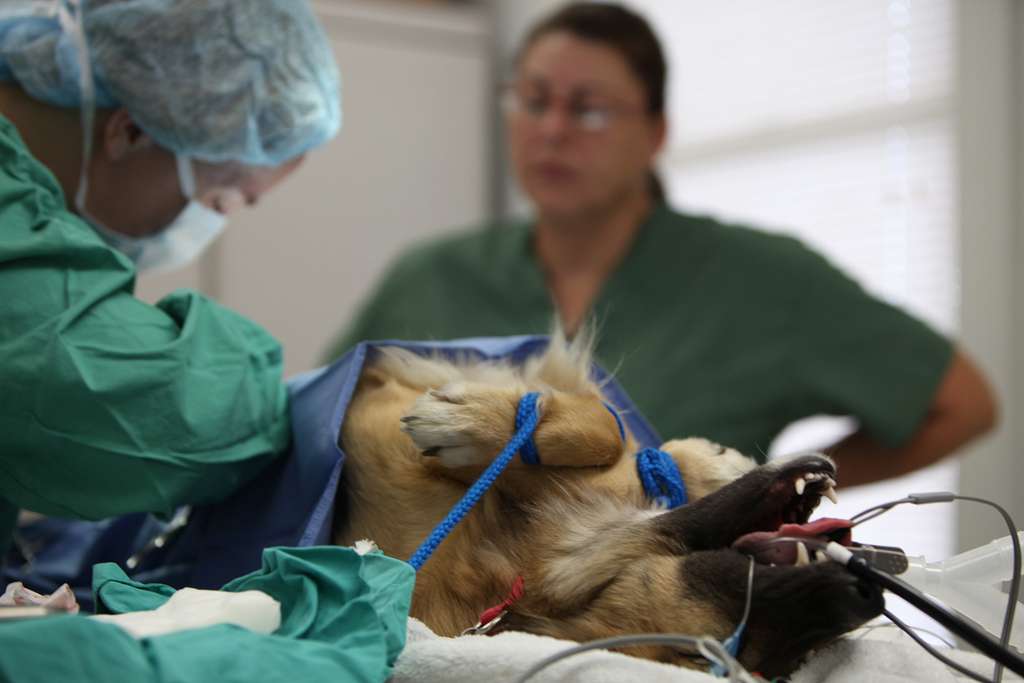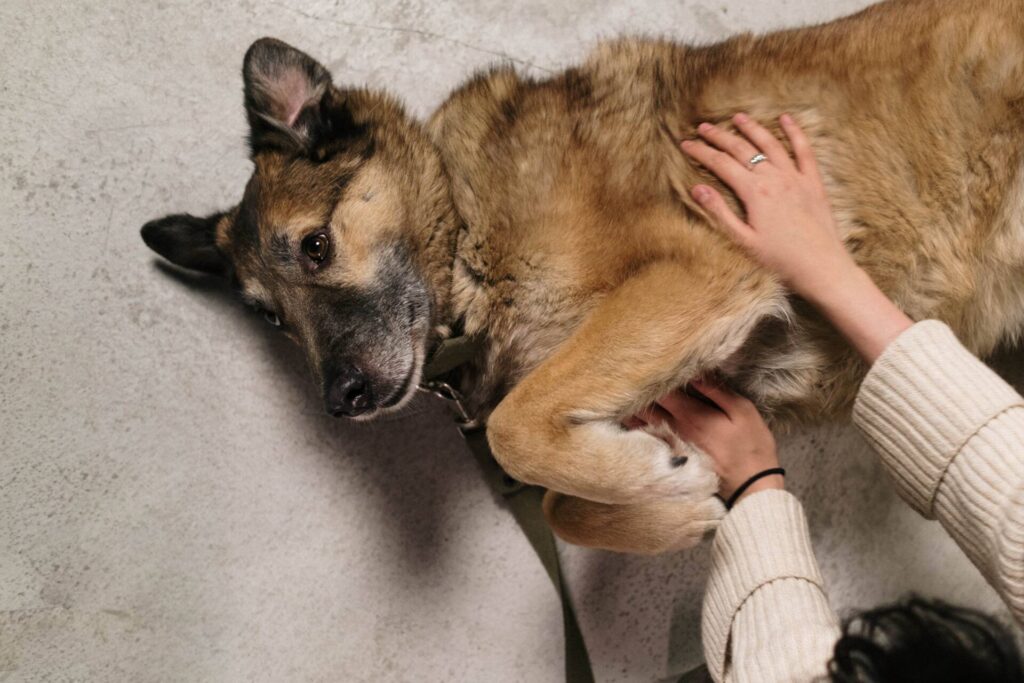When Should I Spay or Neuter My German Shepherd? (+Alternative Approaches)
German Shepherds, known for their intelligence and versatility as working dogs, are one of the most popular breeds around the world.
As a responsible German Shepherd owner, one of the key decisions you’ll have to make is when or if you should spay or neuter your pet. This decision can impact the health, behavior, and overall well-being of your furry friend.
Let’s delve into what spaying and neutering are, and when it might be the best time to consider these procedures for your German Shepherd.
Key Takeaways
- Spaying and neutering are surgical procedures that prevent male and female dogs from reproducing and offer additional health and behavioral benefits.
- For German Shepherds, delaying spaying or neutering until closer to physical maturity may prevent certain orthopedic issues.
- Besides traditional spaying and neutering, alternatives like vasectomies and chemical sterilizations exist, each with unique pros and cons.
What are Spaying and Neutering?
Spaying is a surgical procedure for female dogs. It involves removing the ovaries and usually the uterus. This means your furbaby won’t be able to get pregnant.
The main goal is to prevent unwanted pregnancies, but spaying also brings health benefits. It can reduce the risk of certain diseases, keeping your pup healthy and happy.
Neutering, also known as “castration,” is the surgical removal of a male dog’s testicles. This stops your dog from fathering puppies.
Neutering can also help curb some unwanted behaviors. Plus, it can lower the risk of certain health issues in your pup.

When Should You Spay or Neuter Your German Shepherd?
Deciding when to spay or neuter your German Shepherd is a big decision. It’s one you should make with plenty of research and a chat with your vet.
The timing can affect your dog’s health, development, and even their behavior. So, it’s essential to get it just right for your pup’s needs.
The Best Age to Spay a Female German Shepherd
For your female German Shepherd, the decision to spay revolves around age, size, and health. Let’s look into the details to help you make the best choice for your furbaby.
Age Consideration
Traditionally, vets recommended spaying dogs around six months of age. But, new research suggests that waiting a bit longer might be better for larger breeds like German Shepherds. Why? Because hormones before spaying play a crucial role in bone and joint development.
First Heat Cycle
Some vets now advise waiting until after your pup’s first heat cycle. Experiencing this cycle can provide protective hormonal benefits, especially for bone and joint health. German Shepherds usually hit their first heat between 6 to 12 months, though it can vary.
Physical Development
German Shepherds are a large breed, and their growth plates take longer to close than those of smaller breeds. Early spaying might lead to longer bones and a taller stature. This isn’t inherently harmful, but it can potentially increase the risk of orthopedic issues like hip dysplasia.
Health Risks and Benefits
Delaying spaying can reduce the risk of certain orthopedic conditions. However, it might increase the risk of mammary tumors or pyometra, a life-threatening uterine infection, later in life.
Best Age to Neuter a Male German Shepherd
Determining the best age to neuter your male German Shepherd involves considering health, behavior, and physical development.
Age Consideration
Traditionally, vets suggested neutering dogs around six months old. However, for larger breeds like German Shepherds, recent studies and evolving veterinary practices indicate that waiting might have some benefits.
Physical Development
German Shepherds grow and develop well into their second year of age. Testosterone, produced by the testicles, plays a key role in bone growth.
Early neutering, before growth plates close, can lead to slightly longer bones. This might give your dog a taller stature but can also increase the risk of orthopedic issues like hip and elbow dysplasia or cruciate ligament injuries.
Behavioral Considerations
Testosterone influences behaviors such as marking, humping, and sometimes aggression. Neutering can reduce or eliminate these behaviors. However, if you wait too long, these habits might become ingrained, making them harder to train away later.
Health Risks and Benefits
Neutering reduces or eliminates the risk of certain health issues, including testicular cancer and some prostate problems. However, age of neutering is a risk factor. Dogs neutered too early have increased risk of other conditions, such as joint disorders and cancers.
Veterinary Recommendations
Many veterinarians familiar with larger breeds recommend waiting until the dog is at least 12-18 months old, or even older, before neutering. This is especially true if there aren’t pressing behavioral issues.
Breeding Considerations
If you’re considering breeding your German Shepherd or participating in certain dog shows, you’ll need to hold off on neutering. Always ensure that breeding is done responsibly, focusing on health, temperament, and the betterment of the breed.

What are the Costs of Spaying and Neutering?
Wondering about the costs of spaying or neutering your German Shepherd dog? Don’t worry! I’ve got you covered with all the details to help you budget and make the best decision for your pup. Let’s dive into the factors that affect these costs:
- Location: Vet costs vary by location. Typically, urban areas might charge more than rural spots due to the higher cost of living.
- Veterinary Clinic vs. Low-Cost Clinics: Your local vet may have higher fees than specialized low-cost clinics. Yet, many pet owners stick with their regular vets because of the trust they’ve built.
- Size and Weight of the Dog: Bigger breeds like your German Shepherd often cost more because they need more anesthesia and other materials.
- Age and Health of the Dog: Older or overweight dogs might need extra care during the procedure. Any existing health conditions can also affect the cost.
- Type of Procedure: Spaying generally costs more than neutering as it’s more complex. Some clinics offer less invasive options like laparoscopic spaying, which, while pricier, is gentler.
- Additional Services: The basic fee usually includes the surgery alone. Things like pre-op blood work, pain meds, an e-collar, or follow-up visits can increase the total cost.
- Emergency or Complicated Procedures: If unexpected issues arise or if the surgery is done on an emergency basis, the costs can jump significantly.
- Discounts or Packages: Look out for discounts offered by some clinics for rescue dogs, multiple pets, or bundled services.
Cost Estimates:
- Low-cost clinics or non-profit organizations: Expect to pay around $50 to $150.
- Private veterinary clinics: Costs can range from $200 to $500, with high-end clinics possibly charging more.
Always remember, while budgeting is important, your German Shepherd’s health and safety come first. Before you proceed, ask for a detailed cost breakdown to avoid surprises. Choosing a reputable clinic might cost a bit more, but your beloved pup is worth every penny.
Risks and Considerations Before Spaying or Neutering Your German Shepherd
Spaying and neutering come with a ton of perks, like helping with population control and lowering the risk of certain illnesses when compared to intact dogs. But, it’s not all smooth sailing, especially for your beloved German Shepherd.
There are a few hiccups to consider—like risks linked to anesthesia and surgery. Plus, these procedures might slow down bone growth, which can lead to orthopedic issues, and there’s a chance your pup could pack on some extra pounds or show changes in behavior.
Did you know? Some studies point out that there might be an increased risk of certain cancers or urinary incontinence in females after the surgery. And when’s the right time to do it?
Well, that’s up for debate. Some experts recommend waiting until your furbaby is fully grown, especially for large breeds.
How Long Does it Take a Dog to Heal from Being Spayed/ Neutered?
Wondering how long it takes for your pup to bounce back after being spayed or neutered? While it varies a bit between girls and boys, the healing timeline is generally pretty similar. Here’s a quick rundown of what to expect:
Immediate Post-Surgery: Post-op, your furbaby might be a bit groggy or seem out of it — that’s the anesthesia wearing off. This woozy feeling usually clears up within a few hours.
First 24-48 Hours: During this time, expect your dog to be a bit less peppy. They might snooze more, eat less food, and not be as keen on playing. It’s super important to keep things low-key and steer clear of any wild playtime.
First 7-10 Days: This stretch is crucial for making sure their incision heals up nicely. Make sure your pup doesn’t lick or scratch at their stitches. You might need to deploy the dreaded e-collar (yep, the cone of shame) to keep them from messing with the site. Keep your pooch’s activity limited to gentle, leashed walks when it’s time for a bathroom break.
10-14 Days Post-Surgery: By now, you should see some good healing on the outside. You might have a vet visit lined up to check on the incision and take out any stitches that don’t dissolve on their own.
Full Recovery: The outer wounds should heal in a couple of weeks, but the inside bits need a bit longer to fully mend. Generally, your dog should be back to their usual playful self, running and romping around, about 4-6 weeks after surgery.
Boys usually have a slightly quicker recovery since neutering is less invasive than spaying. But, no matter what, keeping their activity limited in the early stages is key to a smooth recovery.
Always follow the care tips your vet gives you post-surgery. If you spot anything weird like swelling, discharge, or if your pup seems unusually tired, get on the phone with your vet. It’s always better to be safe and get things checked out!
Top 10 Tips After the Spay/ Neuter Procedure
Just brought your pup home after a spay or neuter? Awesome! Here’s how you can make sure they have a smooth and comfortable recovery:
- Limit Physical Activity: For the first week or so, keep things chill for your furbaby. No exercising, running, jumping, or roughhousing that could mess with their stitches.
- Monitor the Incision Site: Take a peek at the surgical site every day. A bit of swelling’s normal, but if it gets worse or you spot redness, discharge, or a funky smell, give your vet a ring.
- Use an E-Collar: To stop your pup from licking their stitches, the cone of shame might be necessary. It’s not fun, but it really helps keep the area safe.
- Follow Medication Guidelines: If your vet prescribed meds, like painkillers or antibiotics, make sure you stick to the schedule and finish up all the meds.
- Maintain a Calm Environment: After surgery, your dog might be a bit out of it. Set up a quiet, cozy spot for them to rest and recover without too much noise or fuss.
- Offer Light Meals: Post-op, your dog might not be super hungry. Try giving them smaller, lighter meals to start, and keep an eye on their water intake. If they’re not eating after 24 hours, a quick call to your vet is a good idea.
- Avoid Baths: Keep your pup dry and skip baths for at least 10 days after surgery to avoid getting the incision wet.
- Limit Interaction with Other Pets: Other pets might accidentally bump the sore spot, so keep a close watch when they’re together, especially in the first few days.
- Attend Follow-up Appointments: Don’t skip those post-op checkups. They let your vet ensure everything’s healing up nicely and catch any issues early.
- Watch for Behavioral Changes: Keep an eye out for signs your dog is in pain, like whining more than usual or acting restless. If something seems off, it’s vet time.
Every pup heals differently, so always follow the specific instructions from your vet. And remember, if you’re ever unsure or worried, your vet’s just a call away. Let’s make sure your pup gets back to their happy, playful self as soon as possible!
Are There Any Alternatives To Spaying And Neutering?
Did you know there are other ways to manage your dog’s reproductive health besides the usual spay and neuter surgeries?
Yet, each alternative comes with its own pros and cons. It’s super important to chat with your vet to figure out what’s best for your pup and your situation. Here’s a look at some options:
- Vasectomy (for males)
Overview: A vasectomy cuts the vas deferens, stopping sperm but not affecting testosterone production.
Pros: Keeps natural hormonal balance, possibly supporting better health and behavior.
Cons: Doesn’t stop all male behaviors linked to mating and misses some health benefits of full neutering. - Tubal Ligation (for females)
Overview: Like a vasectomy, but for females; ties off fallopian tubes to block eggs.
Pros: Maintains hormonal cycles.
Cons: Females will still go into heat and won’t gain certain health benefits from full spaying. - Ovary-Sparing Spay
Overview: Removes the uterus but keeps ovaries to preserve hormonal function.
Pros: Prevents pregnancy while keeping some health perks of spaying.
Cons: Females continue to experience heat cycles. - Chemical Sterilization
Overview: Uses injections to sterilize males.
Pros: Non-surgical and less invasive option.
Cons: Less reliable than surgery, with potential side effects and limited availability. - Hormonal Birth Control
Overview: Medications suppress the reproductive cycle, similar to human birth control.
Pros: Non-surgical and reversible by stopping medication.
Cons: Requires ongoing medication, may have side effects, and doesn’t offer the full health benefits of spaying or neutering. - Breeding Contracts
Overview: Used primarily in purebred dogs for controlled breeding.
Pros: Promotes responsible breeding practices.
Cons: Requires careful management and can lead to complications if breeders don’t manage it properly.
Keep in mind, despite these alternatives, traditional spaying and neutering are still the top choices recommended by veterinarians for controlling the pet population and enhancing health benefits.
Conclusion
Deciding whether and when to spay or neuter your German Shepherd is a decision steeped in both medical and ethical considerations. Beyond the fundamental health and behavioral aspects, responsible pet ownership calls for a deeper understanding of the procedure’s broader implications.
Balancing health, behavior, costs, and ethical responsibilities will ensure that both you and your German Shepherd enjoy a harmonious and healthy relationship for years to come.
Frequently Asked Questions About German Shepherd Spaying And Neutering
Should you let a female dog go into heat before spaying?
It’s a common question with different viewpoints. Some experts suggest waiting until after the first heat for hormonal development, while others recommend early spaying to reduce the risk of certain health issues. It’s best to discuss the timing with your veterinarian based on your dog’s health and lifestyle.
What age do female German Shepherds go into heat?
Intact females typically experience their first heat cycle between 6 to 12 months of age. However, this can vary based on individual factors including breed size and overall health.
Is it better to spay your dog early or late?
The best time to spay your pup can vary. Spaying early helps reduce the risk of mammary tumors, but waiting a bit might be better for their joint health. It’s all about finding the right balance for your furry friend.
Do male German Shepherds calm down after neutering?
Neutering can often help calm a male German Shepherd by reducing aggressive tendencies and hyperactive behavior linked to hormones in intact males. However, it’s not a guaranteed fix for all behavior issues; training and environmental factors also play significant roles.
How will neutering change my German Shepherd?
Neutering a German Shepherd can lead to behavioral changes such as reduced aggression and less marking territory. Physically, it prevents breeding and reduces the risk of certain diseases. Always consult your vet to understand how these changes might specifically affect your dog.

